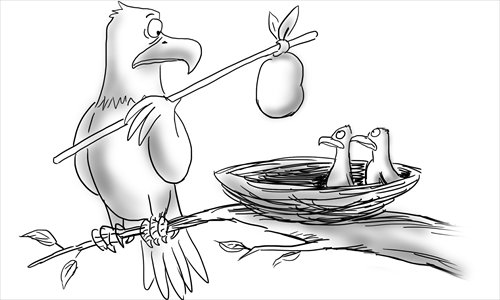HOME >> OP-ED
US withdrawal unavoidable for peace in Asia
By Ding Gang Source:Global Times Published: 2016-3-31 2:22:01

Illustration: Liu Rui/GT
US Republican presidential candidate Donald Trump suggested recently that the US stop financially supporting the defense of South Korea and Japan, and encourage them to build up their own forces, even suggesting they possess their own nuclear arsenals. His proposal has caused quite a stir in Northeast Asia, giving hope to pro-nukes people in the two countries.Trump's suggestion, as with the ideas he has articulated for US domestic and diplomatic policies, once again shows his outspokenness. His high support indicates US public is unease about the country's ability to provide security assurance to its allies.
Trump's words have triggered stronger responses in Japan and South Korea. For one thing, the two are US military allies and the nuclear umbrella provided by the US is the foundation of the alliances.
For the other, it may generate an arms race in the region, which might lead to a nuclear face-off. This scenario will precipitate a Cold War-like fright in the region.
Trump's suggestion has responded to the reality that the security framework in Northeast Asia is a remnant of the Cold War. The nuclear risks haunting Northeast Asia are the side effect of the long-standing confrontations in the region. The nuclear threat cannot be fully eradicated until the confrontations are resolved.
The pro-nuclear people in Japan and South Korea insist that only by having nuclear weapons can they feel secure. But to a larger extent, what they really want is the withdrawal of US forces from their soils since they have nuclear deterrence to defend themselves, so that both countries can claim complete political independence.
Right-wing extreme forces may constitute part of the pro-nuclear voices, but the majority of the supporters are common people who are pursuing national dignity.
The US will have no reason to station its military forces in Japan and South Korea any more if a long-term peaceful architecture can be built in Northeast Asia.
However, the problem is that the US has shifted the nuclear umbrella, created during the Cold War to counter then Soviet Union, to contain China. The rivalry has become an issue in Sino-US relations.
The system is not completely positive for the US. Rather, it might be a burden that is hard to get rid of. In the long run, the US must invest a huge amount of manpower and material resources into it, which may also trigger dissatisfaction among people from its allies.
Former US national security advisor Zbigniew Brzezinski once predicted that the biggest challenge for the US in the future was the shift of power in East Asia.
As regional peace is shared by both China and the US on their agendas, it is time to discuss how the US army withdraws from the region and how to build a regional peace framework in post-withdrawal era.
When conditions become ripe, this topic can be included in the Six-Party Talks that aim to solve North Korea's nuclear issue. This will benefit all stakeholders in the long term.
It may be impossible to bring this proposal into reality before Pyongyang abandons its nuclear ambitions.
Nonetheless, the denuclearization of the Korean Peninsula and US withdrawal have become increasingly intertwined.
If the US is sincere about articulating a long-lasting peace mechanism in the Asia-Pacific with China, and if all regional stakeholders want to see a peaceful environment that caters to their joint development in Northeast Asia, discussions about US withdrawal may be unavoidable sooner or later.
The author is a senior editor with People's Daily and currently a senior fellow with the Chongyang Institute for Financial Studies at Renmin University of China. dinggang@globaltimes.com.cn. Follow him on Twitter at @dinggangchina
Posted in: Columnists, Viewpoint